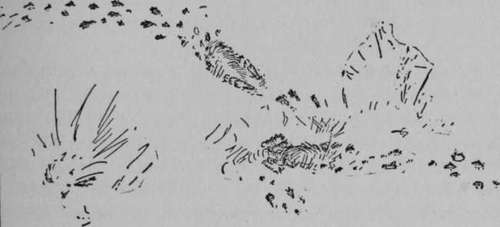The Newton Jack Rabbit
Description
This section is from the book "The Book Of Woodcraft", by Ernest Thompson Seton. Also available from Amazon: The Book of Woodcraft.
The Newton Jack Rabbit
During February of 1902, I found myself with a day, to spare in the hotel office at Newton, Kan. I asked the usual question, "Any wild animals about here?" and got the usual answer, "No, all been shot off." I walked down the street four blocks from the hotel, and found a jack-rabbit trail in the snow. Later I found some cottontail tracks, though still in town. I walked a mile into the country, met an old farmer who said that "No rabbits were ever found around here." A quarter of a mile away was an orchard, and beside it a fence half buried in snow drifts that were yellow with tall dead grass sticking through. This was promising, so I went thither, and on the edge of the drift found a jack-rabbit form or den, with fresh tracks leading out and away at full speed. There were no tracks leading in, so he must have gone in there before the last snow came, and that was the night before.
When a jack runs without fear of any enemy at hand, he goes much like a fox or an antelope, leaving a trail, as in No. 5. But when an enemy is close at hand he runs with long, low hops, from six to seven in succession, then gives an upright leap to take an observation, leaving a trail thus. (Illustration 7).
A silly young jack will lose time by taking one in three for observation, but a clever old fellow is content with one in ten. Here was the trail of this jack straight away, but taking about one observation in twelve hops. He had made a fence a quarter-mile off, and there had sat for some time observing, had then taken alarm and run toward a farmyard, a quarter-mile farther, taking occasional observations. A dog was lying on a doorstep by the road, and past this dog he had run, doing twenty-foot leaps. Two hundred yards down this road he had turned abruptly, as though a human still in sight had scared him. I now began to think the jack was near at hand, although so far I had not seen him. The trail led through several barbed-wire fences and some hedges, then made for another barnyard half a mile off. I was now satisfied that he was only a little ahead of me, therefore I ceased watching the track so closely, watching rather the open plain ahead; and far on, under a barbed-wire fence, sitting up watching me, I soon saw my jack. He ran at once, and the line of his hops, was so - (Illustration 8) - the high ones being for observation.
He never let me get within two hundred yards, and he wasted but little time in observation. He had now taken me on a two-mile circuit and brought me back to the starting point. So he had taught me this - a cunning old jack-rabbit lived in the region around which I had followed him, for they keep to their homeground. All his ways of running and observing, and of using barbedwire fences, barnyards, and hedges, showed that he was very clever; but the best proof of that was in the fact that he could live and flourish on the edge of a town that was swarming with dogs and traveled over daily by men with guns.
The next day I had another opportunity of going to the jack-rabbit's home region. I did not see himself; but I saw his fresh tracks. Later, I saw these had joined on to the fresh tracks of another rabbit. I sketched all the salient points and noted how my big jack had followed the other. They had dodged about here and there, and then one had overtaken the other, and the meeting had been the reverse of unfriendly. I give the record that I sketched out there in the snow. I may be wrong, but I argue from this that the life of the hardy jack was not without its pleasures. (Illustration 9).


No. 9. Where the Jack-rabbit's track was doubled.
Continue to:
- prev: Rabbits And Hares
- Table of Contents
- next: Fox
Tags
bookdome.com, books, online, free, old, antique, new, read, browse, download
